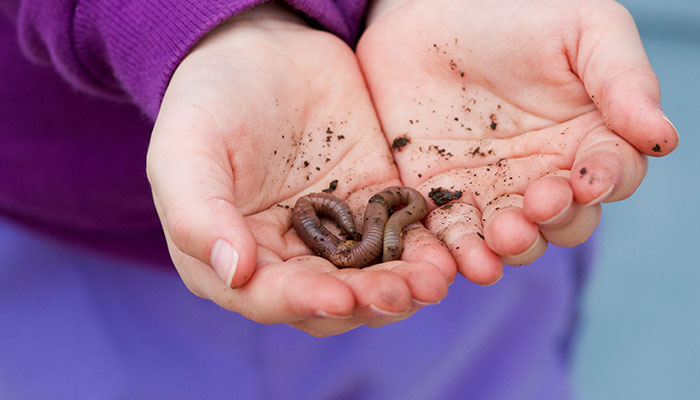While we believe that the books and resources recommended may be of value to you, keep in mind that these are suggestions only and you must do your own due diligence to determine whether the materials are appropriate and suitable for your use. PNC has no sponsorship or endorsement agreement with the authors or publishers of the materials listed.
SPRING

We Like Worms!
Children will learn about earthworms.

Lesson Objective
The children will learn about the many functions of earthworms and their importance in the environment.
Science
What You'll Need
- Live earthworms – 12 or more (available online, bait stores, or dig them up in your garden)
- Paper towels
- Clear container (an aquarium or large plastic pretzel container)
- Empty 1- or 2-liter bottle
- Water mister
- Gravel – enough to cover the bottom of the container
- Potting soil – 1 bag
- Dry leaves – enough for a layer over the gravel
- Disposable gloves – 1 pair per child
- Markers
- Chart paper
What To Do
Note: This activity can be completed in 1 day; observation of the worms will take place over several days.
- Activate background knowledge about earthworms. Write ideas on the chart paper.
- Talk with the children about observing earthworms over the next few weeks.
- Place the earthworms on a wet paper towel away from direct sunlight.
- Talk about how earthworms need moisture to survive.
- Ask the children if they think the earthworms like the towel to be wet, and why.
- Allow the children some time to observe the earthworms.
- Encourage the children to gently touch the worms. Offer disposable gloves to children who express hesitation with touching the worms. Ask them questions about the earthworms such as their color, shape, eyes, legs, and how they move (see Guiding Student Inquiry).
- Place gravel in the clear container. Layer leaves on top of the gravel, then potting soil on top of the leaves.
- If the container is very large, place a 1- or 2-liter bottle filled with water (lid fastened tightly) on its side in the center of the container and surround the bottle with gravel, soil, and leaves. This will stop the worms from going to the middle of the container where the children will not be able to see them.
- Add water to moisten the contents of the container. Do not allow the soil mixture to dry out.
- Punch holes in the lid of the container so the worms have air.
- Over the next few days, observe the earthworms. Chart children’s observations about what the worms are doing in the soil and what is happening to the leaves.
Resources
Home School Resources
Home educators: use these printable lesson PDFs to teach this lesson to your home schoolers. They're available in English and Spanish.
Content Provided By
Common Core State Standards Initiative – These lessons are aligned with the Common Core State Standards ("CCSS"). The CCSS provide a consistent, clear understanding of the concepts and skills children are expected to learn and guide teachers to provide their students with opportunities to gain these important skills and foundational knowledge [1]. Visit the CCSS


